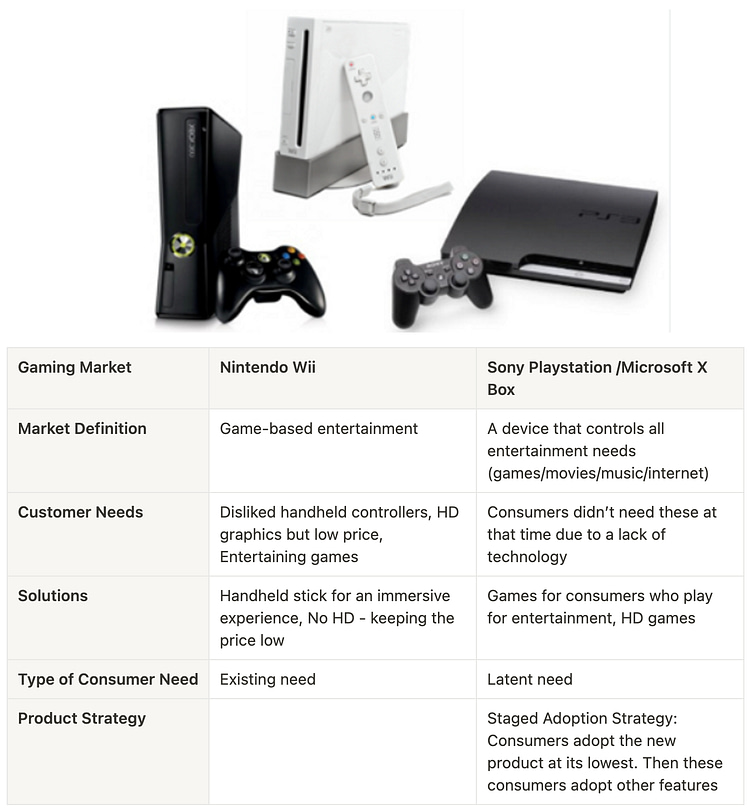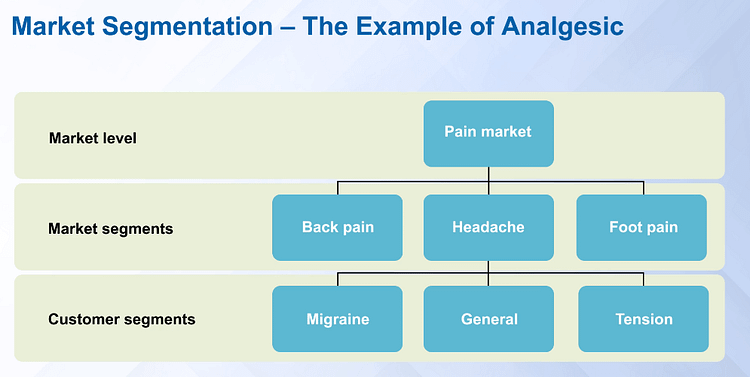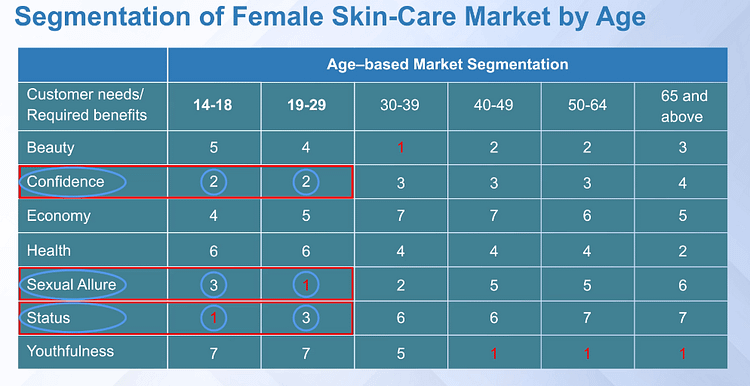In short…
- Understand markets and define them.
- Market segmentation and targeting.
- Create a user persona.
- Define and illustrate the customer journey.
Product Market
Kotler’s Definition of Product Market
- Consumer-centric → heart of Blue Ocean Strategy
- Blue oceans symbolize untapped market spaces, where companies can create and capture new demand, making the competition irrelevant.
- Blue Ocean Strategy encourages businesses to shift their focus from competing in existing markets to exploring new opportunities and creating uncontested market spaces.
- By successfully implementing a blue ocean strategy, companies can achieve sustainable growth, higher profits, and differentiation from their competitors by creating innovative value for customers and capturing new demand.
- Seller is not required for the market to exist
- The same product can be sold in different markets: Laptops in B2B as well as B2C market
- Different products in the same market: Market: Commuting, Products/Solutions: Cars, Bike, Cycle, Walking
Different organizations in the same market can choose to define the market differently. It is based on consumer needs and the solution the organization wants to provide to its customers.
e.g.: In the gaming market, there was a time when Nintendo Wii was the highest-selling brand even with Sony’s Playstation and Microsoft’s X-Box in the market. But Sony and Microsoft had defined the market differently than Nintendo and were competing amongst Sony and Microsoft only.

During competitor analysis,
First focus on the immediate competitor. Sony Playstation vs Microsoft X-Box
Then on the next set of competitors: (Sony Playstation vs Microsoft X-Box) vs Nintendo Wii
Competitors should be decided on the basis of the market and consumer needs, not on the base of the product. E.g.: Jungleworks Panther vs Practo/Graphy/Coursera/AstroSage
Market Segmentation

Why Segmentation?
Because consumers differ from each other, require distinct solutions
Segmentation is costly for each segment since each segment would need different sales, distribution, and marketing strategy
Mass Marketing: One product/solution for the entire market (Maggi/Salt/etc)
One-to-One Marketing: Tailored product to each customer (e.g.: SAP)
Hence segmentation is required so that customers are similar within the segment but differ from other segments. This solves the heterogeneity in the market
Mass customization: With technology, mass customization is possible at the price of mass marketing. This makes switching costs too high for the consumer (e.g.: Apple iPhones provide customized solutions via its apps. One segment can be focussed on Music, another on Books)
Market Segmentation Matrix
- Companies need to decide how many segments to have
- One methodology is to create a matrix of Consumers’ Needs vs Segments.
- Then create a priority list of these needs for each segment
- Then pick segments that have similar priority level of needs

While it may look like the age group 14-18 and 19-29 may be combined in one segment.
But product managers also need to look at how these needs are perceived by the segment.
Status can be perceived differently for the age group 14-18 vs age group 19-29
Developing Market Segments
Two types of approaches and the factors used to develop market segments
- Customer needs first
- Customer descriptor variables (geography, demography, behaviour, socio-psychological) first

Segmentation based on geography, demography, behavior, and socio-psychological factors are commonly used in marketing to divide a target market into distinct groups. Here are the key factors associated with each segmentation criterion:
- Geography:
- Location: Dividing customers based on regions, countries, cities, or specific geographic areas.
- Climate: Considering weather conditions and climate variations that influence consumer preferences and needs.
- Urban vs. Rural: Distinguishing between urban and rural areas, as consumer behaviors and preferences may differ between these settings.
- Demography:
- Age: Grouping consumers based on their age ranges, such as children, teenagers, adults, or seniors.
- Gender: Segmenting consumers based on their gender, recognizing that preferences and needs can vary between males and females.
- Income: Considering the income levels of consumers, such as low-income, middle-income, or high-income brackets.
- Education: Taking into account educational qualifications or levels of attainment.
- Occupation: Considering the types of occupations or professions individuals are engaged in.
- Behavior:
- Usage Rate: Categorizing consumers based on the frequency and volume of product or service usage.
- Loyalty: Identifying loyal customers who repeatedly choose a particular brand or demonstrate high brand affinity.
- Occasion: Segmenting consumers based on specific occasions or events when they are more likely to make a purchase.
- Benefits Sought: Dividing consumers based on the specific benefits they seek from a product or service.
- Buying Behavior: Considering factors such as impulse buying, brand preferences, or decision-making styles.
- Socio-psychological:
- Lifestyle: Segmenting based on consumers’ patterns of living, interests, activities, and opinions.
- Personality: Considering personality traits that influence consumer behavior, such as extroversion, introversion, or risk-taking propensity.
- Values and Beliefs: Identifying consumers with shared values, beliefs, or ideologies that impact their purchasing decisions.
- Social Class: Dividing consumers based on social standing, including factors like income, occupation, and education.
- Motivation: Understanding the underlying needs, desires, or motivations that drive consumer behavior.
It’s important to note that these factors are not exhaustive, and marketers often combine multiple segmentation criteria to create more specific and targeted segments. The choice of factors depends on the nature of the product or service, the market being targeted, and the specific goals of the marketing strategy
6 Criteria for a Good Market Segmentation
When considering market segmentation, there are several criteria that can help determine whether a segmentation approach is effective. Here are six criteria for good market segmentation:
- Measurability: A good segmentation should be measurable, meaning that the characteristics used to divide the market into segments can be quantified or observed. Measurable criteria allow marketers to identify and target specific segments accurately. For example, age and income are measurable criteria as they can be easily quantified.
- Accessibility: Segments should be accessible, meaning that marketers can effectively reach and engage with the target audience within each segment. Accessibility can be influenced by factors such as distribution channels, communication channels, and geographic considerations. If a segment is not accessible, it becomes challenging to effectively serve and target that particular group.
- Substantiality: A good market segmentation should consist of segments that are substantial or sizable enough to justify the allocation of marketing resources. In other words, the segments should be large enough and have sufficient purchasing power to make them economically viable targets for marketing efforts. It is important to focus on segments that have the potential for profitability.
- Homogeneity: A desirable market segmentation should exhibit homogeneity within segments, meaning that consumers within each segment share similar characteristics and needs. Homogeneity implies that the marketing message and strategies developed for a segment can be effectively tailored to meet the specific preferences and requirements of that group. This helps in creating more relevant and impactful marketing campaigns.
- Differentiability: Segments should be differentiable, which means that consumers in different segments should have distinct responses to marketing strategies. If segments cannot be differentiated effectively, it becomes difficult to create unique value propositions and tailor marketing efforts to suit the specific needs and preferences of each segment. Differentiation allows marketers to create a competitive advantage by addressing the unique requirements of specific segments.
- Actionability: A good market segmentation should be actionable, meaning that it provides clear guidelines for developing marketing strategies and tactics. Marketers should be able to identify specific actions to target and serve each segment effectively. Actionability helps in designing marketing campaigns, product development, pricing strategies, and distribution plans that align with the needs and preferences of the target segments.
By considering these six criteria, marketers can develop a market segmentation strategy that helps them understand their target customers better, develop tailored marketing approaches, and ultimately drive business success.
Which Segments to Target?
Step 1: The segment must be an attractive market for the company.
When evaluating the attractiveness of different market segments, several criteria can be considered to determine their potential. Here are a few criteria commonly used to assess segment attractiveness:
- Size: The size of a segment refers to the total number of potential customers within that segment. Larger segments generally offer greater market opportunities and potential for sales and revenue generation.
- Growth Rate: The growth rate of a segment reflects the rate at which the market is expanding. Segments with higher growth rates indicate increasing demand and potential for future sales growth.
- Profitability: Profitability assesses the potential profitability of a segment by considering factors such as profit margins, pricing dynamics, and cost structures. Segments with higher profitability offer better financial returns.
- Competitive Intensity: The level of competition within a segment is an important consideration. Highly competitive segments may pose challenges in terms of market share acquisition, pricing pressure, and differentiation. Less competitive segments may present opportunities for easier market entry and differentiation.
- Accessible and Reachable: Segment accessibility evaluates the ease with which a company can effectively reach and serve the target customers within the segment. Factors such as geographic proximity, distribution channels, and communication channels play a role in determining segment accessibility.
- Compatibility: Compatibility assesses the fit between a company’s capabilities, resources, and core competencies with the requirements of a segment. It considers whether a company has the ability to meet the specific needs and preferences of the target customers within the segment.
- Stability: Segment stability refers to the consistency and predictability of customer behavior within a segment over time. Stable segments with relatively consistent customer needs and preferences provide a more reliable basis for developing long-term marketing strategies.
- Strategic Fit: Strategic fit evaluates the alignment between a segment and a company’s overall strategic goals and objectives. It considers whether serving the segment aligns with the company’s mission, vision, and overall business strategy.
It’s important to note that the importance and weighting of these criteria may vary depending on the specific industry, company, and market context. A thorough analysis of these criteria can help businesses identify the most attractive segments that align with their strategic objectives and maximize their chances of success.
Step 2: Identify Business Strength for a company to succeed in each segment
To succeed in a specific market segment, businesses need to leverage their unique strengths and capabilities. Here are a few business strengths that can contribute to success in a market segment:
- Expertise and Knowledge: A deep understanding of the market segment, including customer preferences, needs, and trends, is crucial. Having expertise and knowledge allows a business to develop tailored products, services, and marketing strategies that resonate with the target customers.
- Differentiation and Unique Value Proposition: Offering a unique value proposition that sets the business apart from competitors is vital. This could be through innovative product features, superior quality, exceptional customer service, or other distinctive elements that address the specific needs and desires of the target segment.
- Strong Brand and Reputation: A strong brand reputation enhances trust and credibility within the market segment. Customers are more likely to choose a business that has a positive brand image, as it signals reliability, quality, and customer satisfaction.
- Effective Marketing and Communication: The ability to effectively market and communicate with the target segment is essential. This includes developing compelling messaging, using appropriate marketing channels, and engaging in targeted advertising and promotional activities to reach and engage with the desired audience effectively.
- Efficient Distribution and Supply Chain: Having an efficient distribution network and supply chain management capabilities enables businesses to deliver products or services to the target segment in a timely and cost-effective manner. Smooth logistics and supply chain operations contribute to customer satisfaction and loyalty.
- Flexibility and Adaptability: Being able to adapt to changing market dynamics and customer needs is crucial for long-term success. Businesses that can quickly respond to market shifts, introduce new products or services, and adapt their strategies based on evolving customer preferences have a competitive advantage.
- Customer Relationship Management: Building strong relationships with customers in the segment is essential. Effective customer relationship management practices, such as personalized experiences, post-sales support, and ongoing communication, help foster customer loyalty and retention.
- Financial Resources and Stability: Adequate financial resources and stability provide a solid foundation for investments in product development, marketing initiatives, and operational efficiencies. It enables businesses to make strategic decisions and sustain their efforts in capturing and serving the market segment effectively.
These business strengths are not exhaustive, and the specific strengths required may vary depending on the nature of the market segment and the industry. It’s important for businesses to identify and leverage their unique strengths to create a competitive advantage and succeed in their chosen market segment.

The closer this match of attractiveness, business strength, and segment, the higher chances of success.
Customer Persona
Persona is creating an imaginary person who is your target customer. This persona represents your target market in terms of geography, demographics, psychographic and behavioral attributes.
At least one persona for each segment
There can be multiple personas for each segment as well since there are sub-segments
This leads to consumer centricity (focus on consumers, rather than the product)
This way marketing becomes more effective since the campaigns are relatable.
It also creates consistency between different departments of the organization
Steps of Strategic Marketing
- Understanding consumer needs
- Defining the market
- Segmenting the market
- Targeting the segments
- Planning the positioning of the product/service
Characteristics of a good consumer persona
- Relatable: Targeted customer should be able to relate to the consumer
- Concise: Brief description of persona focussing on the essence of the persona
- Researched: Market research for customer needs and behavior
- Structured: Engaging and attractive flow chart
How to Build Customer Personas?
Consumer personas, also known as buyer personas or customer avatars, are fictional representations of target customers that help businesses better understand and cater to their needs, preferences, and behaviors. While the specific factors included in a consumer persona can vary depending on the industry and target audience, here are some major factors commonly included in a consumer persona:
- Demographic Information:
- Age
- Gender
- Income level
- Education level
- Occupation
- Marital status
- Family size
- Psychographic Characteristics:
- Interests and hobbies
- Values and beliefs
- Lifestyle preferences
- Personality traits
- Attitudes and opinions
- Media consumption habits
- Social media usage
- Behavioral Factors:
- Purchasing behavior
- Decision-making process
- Buying preferences (online vs. offline, in-store vs. e-commerce)
- Brand loyalty
- Product usage patterns
- Awareness of industry trends
- Interaction with customer service
- Goals and Challenges:
- Goals and aspirations related to the product or service
- Pain points and challenges faced
- Motivations and drivers behind purchasing decisions
- Desired outcomes or benefits sought
- Obstacles or barriers that may prevent conversion or engagement
- Buying Journey:
- Awareness stage: How the persona becomes aware of the product or service
- Consideration stage: Factors considered during the decision-making process
- Purchase stage: Preferred channels, touchpoints, and criteria for making a purchase
- Post-purchase stage: Feedback, satisfaction levels, and the likelihood of referrals or repeat purchases
- Communication Preferences:
- Preferred communication channels (email, social media, phone, in-person)
- Frequency of communication desired
- Content formats preferred (text, images, videos)
- Tone and language preferences
- Key influencers or trusted sources of information
Customer Journey
A Short Introduction to Customer Journey Maps
The customer journey is a series of touchpoints the customer has before making the purchase
Different persona generally have different customer journey
A customer journey map is a cross-functional strategic management tool
How to design a customer journey map
- Identify the segments that are attractive for the company.
- Identify Business Strengths for a company to succeed in each segment
- Match business strength with the segment attractive for the company
- Identify customer persona for that segment
- List all customer touchpoints
- Understand how consumer persona moves across different touchpoints
Customer Journey Timeline
- Pre-purchase period
- Purchase period
- Post-purchase period
144 Best Customer Journey Map Templates and Examples
Google Slides: https://docs.google.com/presentation/d/1XnpZccR5Ukwb0KpStSPLXgsHUe14yGm7_e1LyVmiWCo/edit#slide=id.gae6108f774_0_561
Buyer Persona: Motor Insurance Customer - Delhi, India (Example)

Note: These are notes from the ISB Executive Education – Product Management program for my personal consumption.
In case you are looking for a Product Management course, I would highly recommend joining this cohort-based course.
PS: You can connect with me for review or referral discount (link for referral discount)



